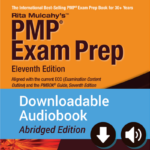Since the publication of “Rita Mulcahy’s PMP Exam Prep, Ninth Edition” back in January, we have been getting a number of questions asking why the book does not cover Agile Process. These readers note that A Guide to the Project Management Body of Knowledge (PMBOK® Guide) – Sixth Edition, discusses Agile through out and is shipped in a package set with the “Agile Practice Guide.” Seeing what they consider an obvious disconnect they reasonably ask whether RMC is suggesting that there will be no Agile questions on the PMP exam.
The simple answer to the question is “no.” The PMP exam will most likely not specifically test on Agile. That answer, however, does require some explanation.
A complete answer to this question requires us to look at the nature of the PMP exam generally as well as how the Project Management Institute (PMI) treats Agile along with other iterative, incremental and hybrid approaches to project management.
For anyone contemplating taking the PMP Exam, it is important to note that the PMP Exam is not a test of the PMBOK® Guide – Sixth Edition or the Agile Practice Guide. Those guides are used as reference materials for the development of the exam.
To become a PMP, a project manager needs to have an intimate knowledge of project management processes, tools and techniques. The project manager must also be able to apply these processes, tools and techniques to different project environments. Project management is not “one size fits all.” The PMP exam presents a series of situational questions to test the project manager’s ability to correctly apply these processes, tools and techniques to various types of projects. These questions include scenarios describing predictive, incremental, iterative, hybrid, and adaptive project life cycle approaches. Agile is considered an adaptive approach to project management. The exam is about how a project manager tailors their project management to the type, level and visibility of a project.
Project tailoring is mentioned throughout the PMP Exam Prep 9th Edition. Many of these tailoring references provide insight to applying to various project life cycle approaches including Agile (also often referred to as adaptive and/or change-driven). See PMP Exam Prep 9th Edition Chapter 3.
If you look at Page 234 of the PMBOK Guide, you will note that in the section entitled “Considerations for Agile/Adaptive Environments,” the Guide discusses modifying the requirement for detailed cost calculations to one where costs are more generally estimated in situations where project scope is uncertain. These “Considerations” relating to Agile are found throughout the PMBOK Guide and provide a very general discussion of applying project management processes, tools and techniques to an Agile environment; however, as with cost management, the Guide does not provide any details on how to specifically implement these adaptations. Costs still need to be dealt within an Agile environment but not with the up front estimating detail as would be required in a waterfall or plan driven environment. While the PMBOK Guide provides for a high-level modification to the cost management plan in an Agile environment, it doesn’t go into specifics on how a practitioner would do that. For purposes of the PMP Exam, a prospective PMP would still have to learn all of the Cost Management tools and techniques described in the 7th Chapter of the PMBOK Guide.
Of course, anyone interested in drilling down more deeply into specific Agile tools and techniques, Check out Mike Griffiths blog post “Why you May Want to Get Your PMI-ACP® Certification,” Or purchase our “PMI-ACP Workbook”, by Mike Griffiths, but this would be way more information than would be necessary for the PMP.
It’s important to note that Agile techniques and outputs have become more common and are now part of general project use. We are finding Agile Process in most project management approaches. Indeed, many have been incorporated to such an extent that they are no longer identified as Agile processes. For example, in our discussion of “Rolling Wave Planning” in Chapter 6 of the PMP Exam Prep 9th Edition we talk about the applicability of this technique to “change-driven” and “plan-driven” projects. Not once do we refer to Agile. Other examples include the fact that the “Team Charter” is now an output of Plan Resource Management (9th Edition page 375) and “Fist of Five” is now a decision-making technique used in Estimating Activity Durations. See PMP 9th Edition page 237. Both of these are normally used in an Agile environment.
In preparing for the PMP Exam students should expect questions relating to Agile on how the project manager is tailoring the processes, tools and techniques to a “change-driven” development (Agile) approach. This tailoring often takes the form of less formality and less documentation than we would otherwise see in more plan-driven project management approaches.
If you have questions regarding Rita Mulcahy’s PMP® Exam Prep Book – Sixth Edition and related product updates, please contact info@rmcls.com or visit our Products Timeline Release page on our website for updates.
Project Management Professional (PMP)®, PMI Agile Certified Practitioner (PMI-ACP)®, and A Guide to the Project Management Body of Knowledge (PMBOK® Guide) – Sixth Edition are registered trademarks of the Project Management Institute, Inc.
- Scope Management for Agile, Hybrid or Predictive - June 7, 2023
- Project Scope and Business Environment Impact - June 8, 2022
- What Makes an eLearning Course “Good”? - March 30, 2022






